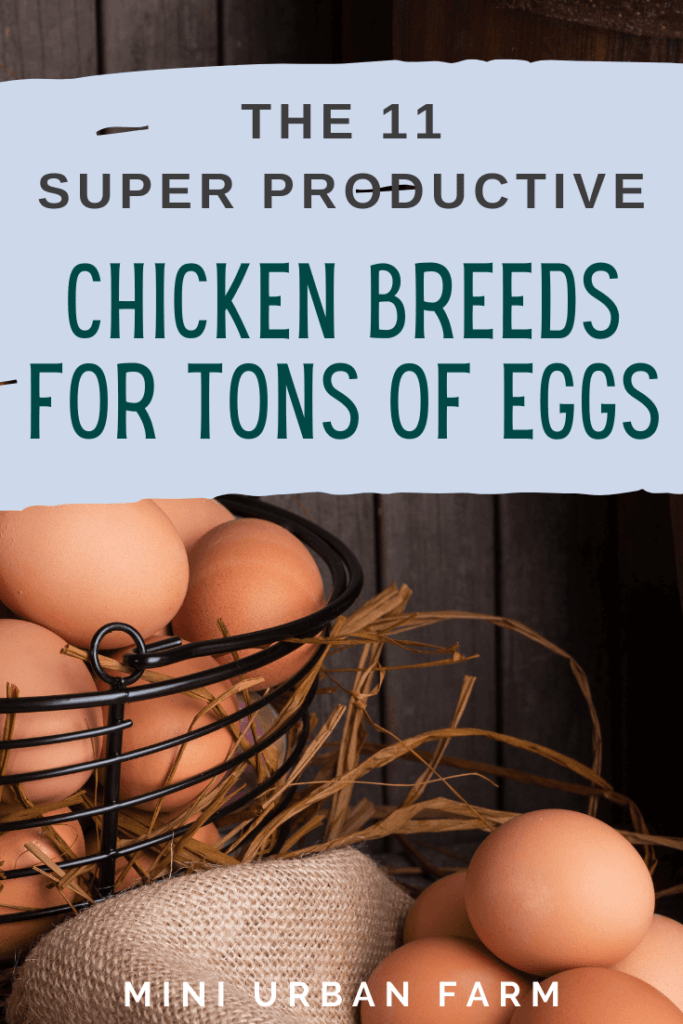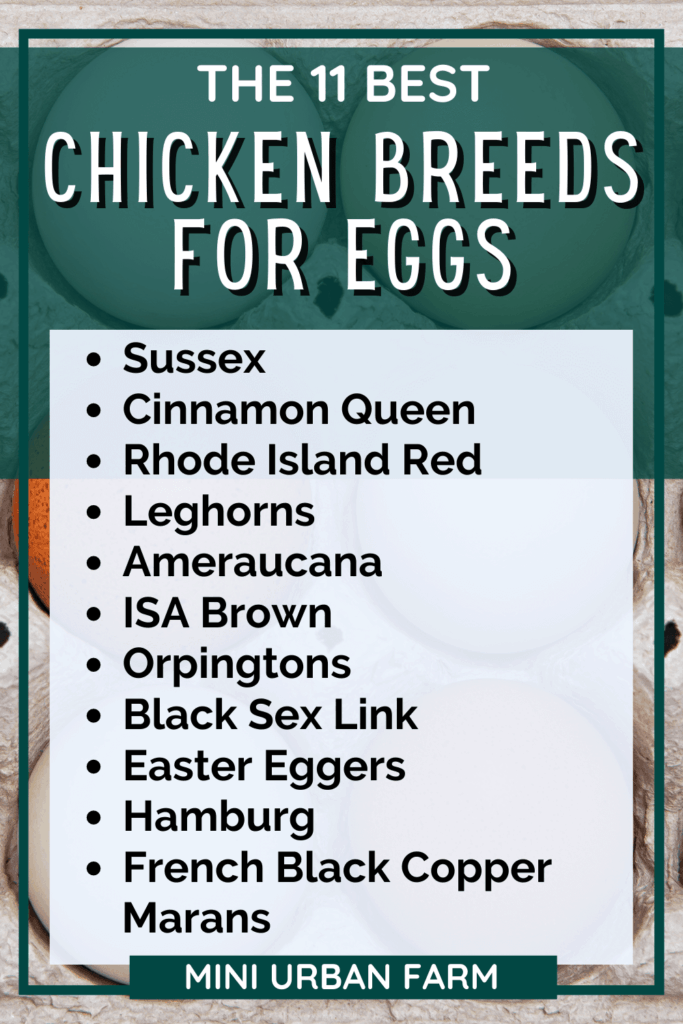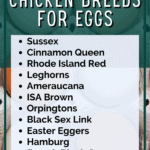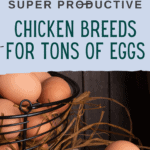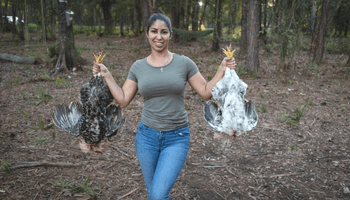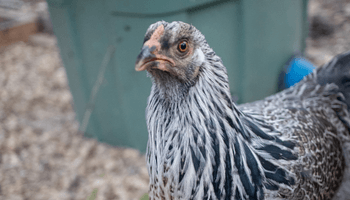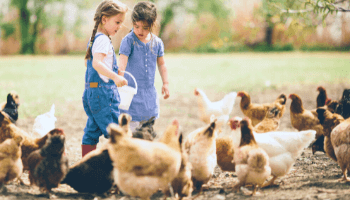Collecting eggs from your backyard chickens is a feeling that will never get old. But there are some breeds of chickens that just don’t give you a great egg harvest. You see, some chickens are better for egg production, some are great for meat production, and some chicken breeds are purely ornamental. So if you’re looking to get started raising chickens for eggs, this list of super productive chicken breeds for eggs will help you make the most of your backyard flock!
Best Chicken Breeds for Eggs:
- Sussex
- Cinnamon Queen
- Rhode Island Red
- Leghorns
- Ameraucana
- ISA Brown
- Orpingtons
- Black Sex Link
- Easter Eggers
- Hamburg
- French Black Copper Marans

Disclosure: This post may contain affiliate links. If you purchase a product through one of our affiliate links we make a small commission from the sale at no extra cost to our readers.
DIFFERENCES BETWEEN EGG AND MEAT CHICKENS
If you’re wondering what the fuss about chickens for eggs and chickens for meat is, the difference starts with the name.
The best egg chickens are referred to as “layers” while the meat chickens are known as broilers or fryers.
Layer chickens are kept solely for laying tons of eggs but are not ideal for meat because they’re smaller and don’t have much meat on their bones.
This is partly due to their breed, and partly due to the kind of food you give them – i.e layer feed.
Broilers, on the other hand, are bulkier, heavier and have more meat on them. The female broilers lay eggs but produce half of the quantity that layers produce.
That’s why finding super productive chicken breeds for eggs is important if you want lots of eggs!
And if you’re looking for both meat and eggs from your flock, check out these amazing dual purpose chicken breeds!
1) SUSSEX
I currently have one Speckled Sussex chicken. And this is one of the best chicken breeds for eggs, although they can be raised for meat too.
This breed is actually a great dual-purpose bird, but many people raised them only for eggs!
The Sussex breed has eight different colors but the common breed is the speckled one. And the prettiest, in my opinion.
They also come in colors such as white, silver, and brown.
A Sussex produces about 250 eggs per year. The eggs are large and the color varies from brown, tan, and cream. But mostly my hen’s eggs are cream-colored.
Sussex chickens are alert, calm, and submissive, but they are also confident and friendly, which makes them good pets.
And my Sussex (her name is Cookies & Cream) is by far the broodiest hen I have!
Sussex chickens are also good at foraging and are curious. You may see them following you in the garden or digging vigorously through a pile of scraps.
They mature fast and are low-maintenance. Also, Sussex chickens lay eggs through the cold weather, making them a good breed to keep for eggs if you live in colder climates.
2) CINNAMON QUEENs
My Cinnamon Queen (named Rosita) is a great layer. And Cinnamon Queens are one of many favorite breeds that I keep in my coop.
They are a relatively new breed of chicken that were bred for modern-age farming.
Because Cinnamon Queens were bred to have super-quick growth and lay many eggs, they grow pretty quick and start laying eggs at a young age.
When they are mature, they can lay between 250 and 300 large-sized brown eggs.
The male Cinnamon Queens are mainly white, while females have a red and brown shade.
Cinnamon Queens are calm and friendly – or so I’m told. They usually get along with other flocks and love to receive affection.
Somehow, Rosita has a bit more attitude than most of my other girls.
And due to their hybrid nature, Cinnamon Queens are hardy and rarely get sick.
3) RHODE ISLAND REDs
My Rhode Island Red is a rooster we call Nugget. He’s a resilient, easy to care for rooster that loves to free-range when he can.
Rhode Island Reds are a popular breed all over the world. They are easy to look after, low-maintenance, and have superb health.
Rhode Island Reds start laying eggs as early as 16 weeks old and are some of the best layers in the entire chicken world.
Rhodes can be used for meat or eggs and are a great dual purpose bird.
A Rhode Island Red can lay 5 to 6 eggs per week, or 250-300 in a year. The egg size is medium to large with a light-brown color.
Rhodes are active foragers and eat seeds, bugs, or even a mouse or frog if they can get their beaks on them.
While the roosters can be aggressive, their female counterparts are friendly and laid back, and enjoy the company of both the humans and chickens, making them a great choice for chicken keepers.
4) LEGHORNS
This breed of chicken is actually the same breed as the ones that lay those white store-bough eggs in most of the country. So you know they produce really well!
Leghorns actually come in more than one color but white is the color most associated with this breed.
However, all leghorns lay white eggs – no matter the color of their feathers!
Since leghorns are thin and not a great choice for meat, most chicken keepers raise the Leghorn for eggs.
And for good reason. They lay between 280 to 320 large eggs per year!
Obviously, they are a favorite for keepers that rear chickens for eggs.
Plus, they are good at foraging and can fend for themselves if allowed to free-range.
Leghorns are active birds and leaving them in confinement can easily cause boredom. So if you have to leave them in their coop, ensure that they have enough legroom.
Plus, they might not be the best breed for kids and families, as they mostly like to be left alone.
5) AMERAUCANAs
I keep three Ameraucana chickens for eggs and I let them forage in the garden as much as I can, and they never disappoint.
An Ameraucana is a free-ranger.
So even though it is okay with being confined, Ameraucanas would rather be left alone to find their food.
They are adaptable to any climate, though too much heat is barely tolerated. They also come in multiple colors, so it’s hard to distinguish a true Ameraucana chicken.
However, a real Ameraucana will have grey legs and feet, instead of the usual colors.
The most distinguishable thing about the breed is that Ameraucanas lay 3 to 4 medium-sized blue eggs a week.
Yes, blue.
And if you’re not familiar with blue and green eggs, let me tell you – they’re amazing!
That equates to about 160 to 210 eggs per year.
I will mention, however, that all of my Ameraucanas lay very well – like almost every day.
And the eggs they produce are some of the biggest in my whole flock!
They are late bloomers though, so you have to wait a little longer for them to start producing their own eggs. But it’s worth the wait, trust me!
Plus, my Ameraucanas usually follow me around more than the others do. And one of them in particular, Henrietta, loves to be pet like a dog!
6) ISA BROWN
ISA Brown chickens were actually developed in the mid 1970s specifically for egg production – making them an amazing chicken breed for eggs!
They are a brown chicken that lays large brown eggs. And they do so very consistently.
In fact, one ISA Brown chicken can lay over 300 eggs per year! And they mature pretty early as well, starting to lay at around 16 weeks.
This is a great chicken breed for families also. They have a mild temperament and are overall pretty calm and docile, making them great for first time chicken keepers and kids!
7) ORPINGTONS
I have a Buff Orpington and two Black Orpingtons I keep for eggs.
Orpingtons are dual-purpose and are kept for both meat and eggs. So if you’re looking into first-time poultry keeping, this breed is perfect for you!
Orpingtons are gentle and peaceful. They are easy to care for and great with children. They are also fluffy and love attention.
For egg-laying, Orpingtons lay 200-280 medium-sized, light brown eggs per year.
Orpingtons can live for more than 8 years, and even though they come in various colors, the most common Orpington is the Buff.
The Buff Orpington is a friendly bird and can be kept as a pet. Orpingtons also tolerate confinement and don’t do well with more aggressive flocks due to their gentle nature.
My Buff Orphington, called Caramel Macchiato (but we call her Caramel for short) is actually pretty feisty, but still friendly overall.
And if you’re into hatching chicks without an incubator, Orpingtons are a great breed for you because they tend to brood more often.
And like the Buff Orpington, Black Orpingtons are great foragers and can lay eggs throughout the year.
They are cold-hardy and can lay through the winter because of their thick feathers that keep them warm in the winter months.
8) BLACK SEX LINK
There are two breeds of sex link chickens: Red and Black.
And for new chicken keepers, sex link means that you can distinguish their sex right at birth.
They are actually a crossbreed of Rhode Island Red roosters and Plymouth Barred Rock hens.
I keep one Black Sex Link for eggs and like to watch her follow me through the garden to ‘help’ pluck out leaves from plants.
Penelope, as we call her, is one of our largest hens – and her eggs are too!
She is a great layer, and has a very distinct temperament. She is at the top of the pecking order for sure!
Black Sex Link chickens, also known as Black stars, are great free rangers that have a strong defense when it comes to predators.
They are fearless chickens and like to forage, but can also tolerate confinement if needed. And while they don’t like being picked up or handled, they’re not entirely shy about being pet.
Although Penny likes to poop on me whenever I try to pick her up.
Coincidence? I think not.
Black Sex Link chickens are also friendly, which makes them a keeper for many poultry farmers.
They lay between 250-300 large-sized brown eggs per year, and many farmers keep them as egg layers, though they can be kept as dual-purpose chickens as well.
9) EASTER EGGERS
First things first. This breed is called Easter Egger for the variety of egg colors it can lay.
And it’s not really a true chicken breed – it’s a mix of a brown egg layer and a blue egg layer. Which means they lay anywhere from blue, to green, to pink eggs!
No wonder why Easter Eggers are a backyard favorite for many poultry keepers!
It is important to mention that if your Easter Egger lays light green-colored eggs, they can’t lay eggs of any other color. The only way you can see rainbow colors in your Easter Eggers is if you have several of them.
Some Easter Eggers have a tail but others are rumpless due to the cross-breed of Araucana and Ameraucana parents.
And Easter Eggers, as much as they’re kept for eggs, also make excellent meat for the table and some farmers breed them as dual-purpose birds. Depending on what other breeds they’re mixed with.
Easter Eggers lay around 250 eggs per year that are medium to large-sized and vary in color.
The hen herself also varies in color.
They also rarely go broody, hence not good for hatching chicks, but I love keeping them around for the wonderfully colored, attractive eggs!
10) HAMBURG
If you haven’t seen a Hamburg before, they’re absolutely beautiful, with their black and white speckled, showy feather coats.
But beauty pageants aren’t the only thing this breed is good for.
Hamburgs mature early, which means they start laying eggs at a young age.
And due to their small stature, Hamburg chickens are not kept for meat. But they are prolific layers!
They lay 3 to 5 small-sized white eggs per week but because they start laying eggs at a young age, you can look forward to many more eggs than you would typically get from other breeds.
They are also tolerant to cold weather – usually up until it hits zero degrees!
11) FRENCH BLACK COPPER MARANS
Although this breed isn’t usually included on lists of the best chickens for eggs, I can’t ignore Marans on my list!
And for one simple reason – they lay chocolate eggs!
Their eggs are dark, darn brown – like the color of the shell, not the inside.
And no, not actual chocolate – just the color.
They are pretty friendly birds, with a calm demeanour. And they do really well in the heat, making them perfect for hotter climates, like where I am!
They lay a decent amount of eggs – about 150-200 per year, and don’t start laying until about 20 weeks. But the color is definitely worth it!
And since I’m all about rainbow eggs, I would be remiss if I didn’t include Marans on this list!
TIPS FOR CHOOSING THE BEST CHICKEN FOR EGGS
All hens lay eggs, but some are more prolific egg layers than others.
So if you’re looking for the best layers, here are a few tips to take into consideration.
- Determine the size of chickens you want, as well as the size and color of eggs you want to keep.
- Consider the weather of where you want to keep your chickens and choose the breed that is hardy to that climate. Some birds do well in cold weather while others are not cold-hardy and can suffer from frostbite. Others don’t do well in hot climates.
- Choose chickens bred specifically for egg production, if you’re not looking to process them. Some are better kept for meat while others are dual-purpose and can be kept for both meat and eggs.
- Determine whether you want eggs for hatching or eating. For hatching, you’ll need a rooster to fertilize the eggs.
- Determine whether you want free rangers or chickens that do better in confinement.
WHAT TO DO WHEN CHICKENS STOP LAYING EGGS?
Chickens stop laying eggs for multiple reasons.
Sometimes this is temporary – I wrote a whole article on why chickens aren’t laying eggs and how to fix it!
But sometimes this is permanent – usually due to old age.
The average egg-laying lifespan of a chicken is about 2-3 years, anything after that they either stop laying altogether, or you’re going to see far fewer eggs!
So what do you do when your chicken stops laying due to old age?
Well you have several options:
- Keep her as a pet – obviously this is only an option if you’re okay feeding something that’s not producing anymore
- Give her away to someone else as a pet – plenty of people want chickens as pets and don’t care if they ever see an egg!
- Process her into dinner – of course, if you named her (as we do with ours) you can’t really behead her and cook her up on the grill – or at least I can’t. No judgement though!
With the above breeds, you can never go wrong when it comes to choosing the most productive chicken breeds for eggs. You’ll be smiling all the way to the bank— or your frying pan. Egg—stounding, isn’t it?
Pin BEST CHICKEN BREEDS FOR EGGS!
